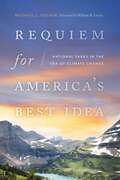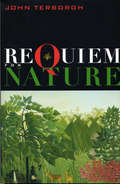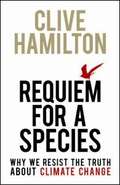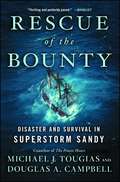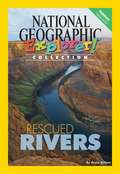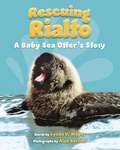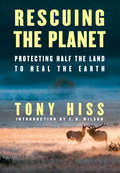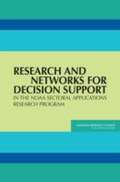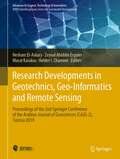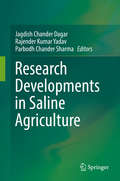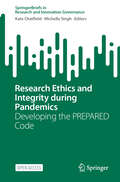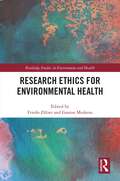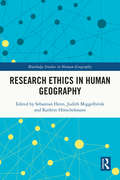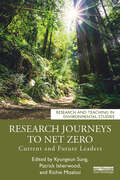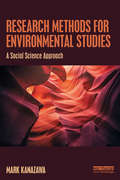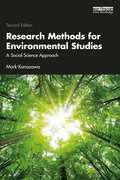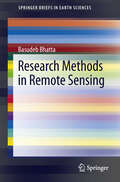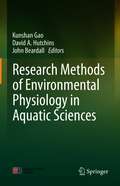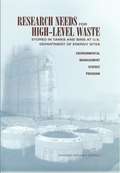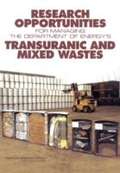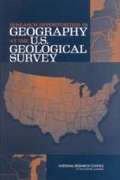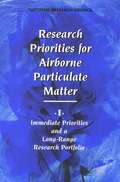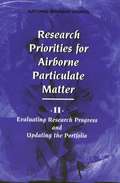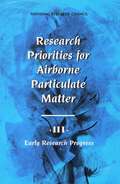- Table View
- List View
Requiem for America's Best Idea: National Parks in the Era of Climate Change
by Michael J. YochimIn his enthusiastic explorations and fervent writing, Michael J. Yochim &“was to Yellowstone what Muir was to Yosemite. . . . Other times, his writing is like that of Edward Abbey, full of passion for the natural world and anger at those who are abusing it,&” writes foreword contributor William R. Lowry. In 2013 Yochim was diagnosed with ALS (Lou Gehrig&’s disease). While fighting the disease, he wrote Requiem for America&’s Best Idea. The book establishes a unique parallel between Yochim&’s personal struggle with a terminal illness and the impact climate change is having on the national parks—the treasured wilderness that he loved and to which he dedicated his life.Yochim explains how climate change is already impacting the vegetation, wildlife, and the natural conditions in Olympic, Grand Canyon, Glacier, Yellowstone, and Yosemite National Parks. A poignant and thought-provoking work, Requiem for America&’s Best Idea investigates the interactions between people and nature and the world that can inspire and destroy them.
Requiem for Nature
by John TerborghFor ecologist John Terborgh, Manu National Park in the rainforest of Peru is a second home; he has spent half of each of the past twenty-five years there conducting research. Like all parks, Manu is assumed to provide inviolate protection to nature. Yet even there, in one of the most remote corners of the planet, Terborgh has been witness to the relentless onslaught of civilization.Seeing the steady destruction of irreplaceable habitat has been a startling and disturbing experience for Terborgh, one that has raised urgent questions: Is enough being done to protect nature? Are current conservation efforts succeeding? What could be done differently? What should be done differently? In Requiem for Nature, he offers brutally honest answers to those difficult questions, and appraises the prospects for the future of tropical conservation. His book is a clarion call for anyone who cares about the quality of the natural world we will leave our children.Terborgh examines current conservation strategies and considers the shortcomings of parks and protected areas both from ecological and institutional perspectives. He explains how seemingly pristine environments can gradually degrade, and describes the difficult social context -a debilitating combination of poverty, corruption, abuses of power, political instability, and a frenzied scramble for quick riches -in which tropical conservation must take place. He considers the significant challenges facing existing parks and examines problems inherent in alternative approaches, such as ecotourism, the exploitation of nontimber forest products, "sustainable use," and "sustainable development."Throughout, Terborgh argues that the greatest challenges of conservation are not scientific, but are social, economic, and political, and that success will require simultaneous progress on all fronts. He makes a compelling case that nature can be saved, but only if good science and strong institutions can be thoughtfully combined.
Requiem for a Species: Why We Resist the Truth About Climate Change
by Clive HamiltonClive Hamilton offers a compelling description of a world transformed by climate change and explains why we won't stop climate change even though we know it will destroy us. This book does not set out to raise the alarm again to encourage us to take radical measures to head off climate chaos. There have been many books and reports in recent years explaining just how dire the future looks and how little time we have left to act. This book is about why we have ignored those warnings, and why it may now be too late. It is a book about the frailties of the human species as expressed in both the institutions we built and the psychological dispositions that have led us on the path of self-destruction. It is about our strange obsessions, our hubris, and our penchant for avoiding the facts. It is the story of a battle within us between the forces that should have caused us to protect the Earth, "our capacity to reason and our connection to Nature "and those that, in the end, have won out "our greed, materialism and alienation from Nature. And it is about the 21st century consequences of these failures.
Rescue of the Bounty: Disaster and Survival in Superstorm Sandy (True Rescue Ser.)
by Michael J. Tougias Douglas A. CampbellFrom the author of the Fall 2015 Disney movie The Finest Hours, the “thrilling and perfectly paced” (Booklist) story of the sinking and rescue of Bounty—the tall ship used in the classic 1962 movie Mutiny on the Bounty—which was caught in the path of Hurricane Sandy with sixteen aboard.On Thursday, October 25, 2012, Captain Robin Walbridge made the fateful decision to sail Bounty from New London, Connecticut, to St. Petersburg, Florida. Walbridge knew that a hurricane was forecast, yet he was determined to sail. The captain told the crew that anyone could leave the ship before it sailed. No one took the captain up on his offer. Four days into the voyage, Superstorm Sandy made an almost direct hit on the ship. A few hours later, the ship suddenly overturned ninety miles off the North Carolina coast in the “Graveyard of the Atlantic,” sending the crew tumbling into an ocean filled with towering thirty-foot waves. The coast guard then launched one of the most complex and massive rescues in its history. In the uproar heard across American media in the days following, a single question persisted: Why did the captain decide to sail? Through hundreds of hours of interviews with the crew members and the coast guard, Michael J. Tougias and Douglas A. Campbell create an in-depth portrait of the enigmatic Captain Walbridge, his motivations, and what truly occurred aboard Bounty during those terrifying days at sea. “A white-knuckled, tragic adventure” (Richmond Times-Dispatch), Rescue of the Bounty is an unforgettable tale about the brutality of nature and the human will to survive.
Rescuing Rialto: A Baby Sea Otter's Story
by Lynda V. Mapes"Calling all sea otter fans!" - KirkusOn a sunny August morning in 2016, a baby sea otter was found washed up on the sand. Orphaned and sick, Rialto was taken to the Seattle Aquarium, where his dedicated caretakers nursed him back to health and taught him how to be an otter. Soon, the charming Rialto was stealing hearts as he played with toys made of ide, swam in his very own pool, ate tasty clams, and floated on his back. Learn about the rescue--and how you can help to save this endangered species--in Rescuing Rialto, from the Seattle Times reporter and photographer who chronicled this story as it happened. Just as he captured them, Rialto's sure to steal your heart, too.
Rescuing the Planet: Protecting Half the Land to Heal the Earth
by Tony Hiss"As clear a picture of humanity's impact on earth's natural environment as any ever written." --E. O. Wilson (from the Introduction)An urgent, resounding call to protect 50 percent of the earth's land by 2050--thereby saving millions of its species--and a candid assessment of the health of our planet and our role in conserving it, from the award-winning author of The Experience of Place and veteran New Yorker staff writer.Beginning in the vast North American Boreal Forest that stretches through Canada, and roving across the continent, from the Northern Sierra to Alabama's Paint Rock Forest, from the Appalachian Trail to a ranch in Mexico, Tony Hiss sets out on a journey to take stock of the "superorganism" that is the earth: its land, its elements, its plants and animals, its greatest threats--and what we can do to keep it, and ourselves, alive.Hiss not only invites us to understand the scope and gravity of the problems we face, but also makes the case for why protecting half the land is the way to fix those problems. He highlights the important work of the many groups already involved in this fight, such as the Indigenous Leadership Initiative, the Yellowstone to Yukon Conservation Initiative, and the global animal tracking project ICARUS. And he introduces us to the engineers, geologists, biologists, botanists, oceanographers, ecologists, and other "Half Earthers" like Hiss himself who are allied in their dedication to the unifying, essential cause of saving our own planet from ourselves.Tender, impassioned, curious, and above all else inspiring, Rescuing the Planet is a work that promises to make all of us better citizens of the earth.
Research And Networks For Decision Support: In The Noaa Sectoral Applications Research Program
by National Research Council of the National AcademiesThis study recommends a definition of “decision support” that emphasizes communication rather than translation and a strategy by which the small NOAA Sectoral Applications Research program can advance decision support. The book emphasizes that seasonal climate forecasts provide fundamentally new kinds of information and that integrating this information into real-world decisions will require social innovations that are not easily accomplished. It recommends that the program invest in (a) research to identify and foster the innovations needed to make information about climate variability and change more usable in specific sectors, including research on the processes that influence success or failure in the creation of knowledge-action networks for making climate information; (b) workshops to identify, catalyze, and assess the potential of knowledge-action networks in particular resource areas or decision domains; and (c) pilot projects to create or enhance these networks for supporting decisions in climate-affected sectors. It recommends that evaluation of the program be addressed with a monitoring approach.
Research Developments in Geotechnics, Geo-Informatics and Remote Sensing: Proceedings of the 2nd Springer Conference of the Arabian Journal of Geosciences (CAJG-2), Tunisia 2019 (Advances in Science, Technology & Innovation)
by Zeynal Abiddin Erguler Murat Karakus Helder I. Chaminé Hesham El-AskaryThis book contains the best peer-reviewed papers accepted for presentation at the 2nd Springer Conference of the Arabian Journal of Geosciences (CAJG-2), organized in Sousse, Tunisia, in November 2019. The short papers cover various topics from the fields of (1) geological and geotechnical engineering, (2) geomechanical studies based on numerical and analytical methods, and (3) geo-informatics and remote sensing. The content of these papers provides new scientific knowledge for further understanding on landslides, new stabilization techniques, importance of geophysics for engineering geology investigations as well as new empirical approaches for easily predicting some physical and hydrogeomechanical properties of geomaterials. The book is of interest to all researchers, practitioners, and students in the fields of geological and mining engineering, geotechnical engineering, hydrogeomechanics, engineering geology, geotechnologies, and natural hazards.
Research Developments in Saline Agriculture
by Jagdish Chander Dagar Rajender Kumar Yadav Parbodh Chander SharmaSoil and water salinity is a major challenge for the agricultural community and policy makers in terms of meeting the burgeoning population’s demand for food and other agricultural commodities. In coastal regions, climate change and sea level rise will aggravate the problem with more and more areas becoming saline due to intrusion of sea water. As such there is a pressing need for modern tools and innovative techniques for the identification of salty soils and poor-quality waters, crop production, soil reclamation and lowering the water table in waterlogged areas. Tackling next-generation problems such as contamination of soil and underground water due to fluoride and arsenic, as well as developing multi-stress tolerant crops is also a high priority. Further, techniques for domesticating halophytes, mangrove-based aquacultures, using seaweed cultures as agricultural crops and integrated farming systems need to be perfected. This book addresses all these aspects in detail, highlighting the diverse solutions to tackle the complex problem of salinity and waterlogging and safer management of poor-quality waters. With chapters written by leading experts, it is a valuable resource for researchers planning future investigations, policy makers, farmers and other stakeholders, and for students wanting insights into vital issues of environment.
Research Directions, Challenges and Achievements of Modern Geography (Advances in Geographical and Environmental Sciences)
by Michael Meadows Jerzy BańskiThis book identifies and discusses research directions, challenges and achievements in contemporary geography. It also documents the most current theoretical and methodological considerations undertaken by scientists representing various sub-disciplines of geography with particular reference to human geography. It was assumed that the thematic structure of the currently active International Geographical Union (IGU) problem commissions corresponds to the most relevant and current research directions in geography. Reflecting this assumption, the book consists of 14 chapters contributed by geographers representing 14 problem commissions of the IGU, which allows us to examine geography from different perspectives and to provide the reader with a complete overview of contemporary research issues in human geography. The first part discusses contemporary research problems and issues related to scientific methodology and achievements of selected geographical sub-disciplines, including urban geography, agricultural geography, transport geography, and political geography, among others. The second part focuses on the interdisciplinarity of geography and the topics of global dimension undertaken by geographers such as global change, GIS and geospatial technology, marginalization, and environmental change. This part also discusses the internal relations between geographical specializations and their links with other related sciences, including geology, sociology, and economics. The third part discusses the holistic approaches of geography applied to particular regions, territories, or conditions (Africa, costal systems, geomorphology and local development).
Research Ethics and Integrity During Pandemics: Developing the PREPARED Code (SpringerBriefs in Research and Innovation Governance)
by Kate Chatfield Michelle SinghThis open-access book is an essential read for anyone interested in pandemic preparedness, research governance, and the ethical oversight of research. It examines the development of a pioneering research ethics framework designed for use during pandemics, guiding readers through the careful development of the PREPARED Code, while highlighting the key steps and lessons learned. The book also underscores the importance of supportive measures, such as user-friendly ethics training, to ensure effective implementation. Drawing from these insights, it offers recommendations for others seeking to develop their own clear, engaging, and accessible ethics code.
Research Ethics for Environmental Health (Routledge Studies in Environment and Health)
by Friedo ZölzerResearch Ethics for Environmental Health explores the ethical basis of environmental health research and related aspects of risk assessment and control. Environmental health encompasses the assessment and control of those environmental factors that can potentially affect human health, such as radiation, toxic chemicals and other hazardous agents. It is often assumed that the assessment part is just a matter of scientific research, and that control is a matter of implementing standards that unambiguously follow from that research. But it is less commonly understood that environmental health also requires addressing questions of an ethical nature. Coming from multiple disciplines and nine different countries, the contributors to this book critically examine a diverse range of ethical concerns in modern environmental health research. This book will be of great interest to scholars and practitioners of environmental health, as well as researchers in applied ethics, environmental ethics, medical ethics, bioethics and those concerned with chemical and radiation protection.
Research Ethics in Human Geography (Routledge Studies in Human Geography)
by Kathrin Hörschelmann Judith Miggelbrink Sebastian HennThis book explores common ethical issues faced by human geographers in their research. It offers practical guidance for research planning and design that incorporates geographic disciplinary knowledge to conceptualise research ethics. The volume brings together international insights from researchers in geography and related fields to provide a comprehensive overview of relevant ethical frameworks and challenges in human geography research. It includes in-depth reflections on a range of ethical dilemmas that arise in certain contextual conditions and spatial constructions that face those researching and teaching on spatial dimensions of social life. With a focus on the increased need for specialist ethics training as part of postgraduate education in the Humanities and Social Sciences and the necessity for fostering sensitivity in cross-cultural comparative research, the book seeks to enable people to engage in ethical decision-making and moral reasoning while conducting research. Chapters examine the implications of geographical research for conceptualising ethics and discuss specific case studies from which more general conclusions, linked to conceptual debates, are drawn. As a research-based reference guide for tackling ethically sensitive projects and international differences in legal and institutional standards and requirements, the book is useful for postgraduate and undergraduate students as well as academics teaching at senior levels.
Research Journeys to Net Zero: Current and Future Leaders (Research and Teaching in Environmental Studies)
by Richie Moalosi Kyungeun Sung Patrick IsherwoodThis book provides useful insight into how academics from diverse disciplinary backgrounds, such as science, engineering, technology, social science, policy, design, architecture, built environment, business, and management, have been conducting research into how to realise net zero emissions to address climate change. This book explores the ways in which countries around the world have pledged to achieve net zero emissions through decarbonisation processes. It presents the highest calibre research and impact activities carried out in the UK, Europe, North America, Australia, Asia, and Africa. Such activities include conceptualisation, opportunity identification, specific case studies, demonstration of proof of concepts, provision of evidence, education of the general public, and knowledge transfer to companies. Further to this, the chapters also bring to light personal career journeys to net zero by current and future international research leaders. From this book, readers will gain a full understanding of net zero research via multiple disciplinary pathways, be inspired by personal accounts, and will learn key methodologies, including quantitative and qualitative approaches. The diversity of authors and topics make the book widely applicable to a range of fields, and it will be of great interest to researchers, students, practitioners, and decision makers working towards the goals of net zero and decarbonisation.
Research Methods for Environmental Studies: A Social Science Approach
by Mark KanazawaThe methodological needs of environmental studies are unique in the breadth of research questions that can be posed, calling for a textbook that covers a broad swath of approaches to conducting research with potentially many different kinds of evidence. Written specifically for social science-based research into the environment, this book covers the best-practice research methods most commonly used to study the environment and its connections to societal and economic activities and objectives. Over five key parts, Kanazawa introduces quantitative and qualitative approaches, mixed methods, and the special requirements of interdisciplinary research, emphasizing that methodological practice should be tailored to the specific needs of the project. Within these parts, detailed coverage is provided on key topics including the identification of a research project; spatial analysis; ethnography approaches; interview technique; and ethical issues in environmental research. Drawing on a variety of extended examples to encourage problem-based learning and fully addressing the challenges associated with interdisciplinary investigation, this book will be an essential resource for students embarking on courses exploring research methods in environmental studies.
Research Methods for Environmental Studies: A Social Science Approach
by Mark KanazawaThe methodological needs of environmental studies are unique in the breadth of research questions that can be posed, calling for a textbook that covers a broad swath of approaches to conducting research with potentially many different kinds of evidence. Fully updated to address new developments such as the effects of the internet, recent trends in the use of computers, remote sensing, and large data sets, this new edition of Research Methods for Environmental Studies is written specifically for social science-based research into the environment. This revised edition contains new chapters on coding, focus groups, and an extended treatment of hypothesis testing. The textbook covers the best-practice research methods most used to study the environment and its connections to societal and economic activities and objectives. Over five key parts, Kanazawa introduces quantitative and qualitative approaches, mixed methods, and the special requirements of interdisciplinary research, emphasizing that methodological practice should be tailored to the specific needs of the project. Within these parts, detailed coverage is provided on key topics including the identification of a research project, hypothesis testing, spatial analysis, the case study method, ethnographic approaches, discourse analysis, mixed methods, survey and interview techniques, focus groups, and ethical issues in environmental research. Drawing on a variety of extended and updated examples to encourage problem-based learning and fully addressing the challenges associated with interdisciplinary investigation, this book will be an essential resource for students embarking on courses exploring research methods in environmental studies.
Research Methods in Remote Sensing
by Basudeb BhattaThis book introduces the overall concepts of research methods in Remote Sensing. It also addresses the entire research framework, ranging from ontology to documentation. As such, it covers the theory while providing a solid basis for engaging in concrete research activities. It is not intended as a textbook on remote sensing; rather, it offers guidance to those conducting research by examining philosophical and other issues that are generally not covered by textbooks. Various stages of research are discussed in detail, including illustrative discussions and helpful references. The topics considered in this book cover a part of the research methodologies explored in Master of Philosophy (M.Phil.) and Doctor of Philosophy (Ph.D.) programs. The book's physical format has been kept to a compact, handy minimum in order to maximize its accessibility and readability for a broad range of researchers in the field of remote sensing.
Research Methods of Environmental Physiology in Aquatic Sciences
by John Beardall Kunshan Gao David A. HutchinsThis book presents methods for investigating the effects of aquatic environmental changes on organisms and the mechanisms involved. It focuses mainly on photosynthetic organisms, but also provides methods for virus, zooplankton and other animal studies. Also including a comprehensive overview of the current methods in the fields of aquatic physiology, ecology, biochemistry and molecular approaches, including the advantages and disadvantages of each method, the book is a valuable guide for young researchers in marine or aquatic sciences studying the physiological processes associated with chemical and physical environmental changes.
Research Needs For High-level Waste Stored In Tanks And Bins At U.s. Department Of Energy Sites: Environmental Management Science Program
by Committee on Long-Term Research Needs for Radioactive High-level Waste at Department of Energy SitesThe committee was charged to identify high-level waste problems that cannot be addressed effectively with current technologies, and to recommend areas of research by which the Department's Science Program can make significant contributions to solving these problems and adding to scientific knowledge generally. The members were selected for their expertise in various relevant fields. The report is not indexed. Annotation c. Book News, Inc. , Portland, OR (booknews. com)
Research Opportunities For Managing The Department Of Energy's Transuranic And Mixed Wastes
by Committee on Long-Term Research Needs for Managing Transuranic Mixed Wastes at Department of Energy SitesAbout 155,000 cubic meters of waste contaminated with both radioactive isotopes and hazardous chemicals are stored at some 30 DOE sites, and another 450,000 cubic meters are buried. While DOE is making a concerted effort to properly dispose of this waste, the amount translates to a multi-decade effort that will require handling, characterizing, and shipping hundreds of thousands of waste containers at a total cost of billions of dollars. This report describes basic scientific research that can lead to new technologies for performing these tasks more safely and cost effectively.
Research Opportunities In Geography At The U.s. Geological Survey
by Committee on Research Priorities in Geography at the U.S. Geological SurveyResearch Opportunities in Geography at the U.S. Geological Survey (USGS) provides perspective and guidance to the geography discipline about its future research and strategic directions. The book makes specific recommendations about scientific research priorities and partnerships within and outside the agency, and outlines a long-term core research agenda for the USGS.
Research Priorities for Airborne Particulate Matter, Volume I: Immediate Priorities and a Long-Range Research Portfolio
by Committee on Research Priorities for Airborne Particulate MatterNew National Ambient Air Quality Standards for airborne particles smaller than 2.5 micrometers, called PM2.5, were issued by the U.S. Environmental Protection Agency (EPA) amidst scientific uncertainty and controversy. In response to a request from Congress, Research Priorities for Airborne Particulate Matter, the first of four books in a series, offers a conceptual framework for an integrated national program of particulate-matter research, identifies the 10 most critical research needs linked to key policy-related scientific uncertainties, and describes the recommended timing and estimated costs of such research.The committee concludes that EPA should devote more resources to investigating the relationships between fixed-site outdoor monitoring data and actual human breathing-zone exposures to ambient particulate matter and to identifying the most biologically important constituents and characteristics of particulate matter through toxicological studies. The recommended research activities are critical to determining actual exposures of human subpopulations most susceptible to harm from the most hazardous constituents of particulate matter. Future research will be an investment in public health and a means to ensure that resources spent on control technology and regulatory compliance will have a reasonable probability of success.
Research Priorities for Airborne Particulate Matter, Volume II
by Committee on Research Priorities for Airborne Particulate MatterIn the effort to reduce the scientific and technical uncertainties over regulation of airborne particulate matter in the United States, Research Priorities for Airborne Particulate Matter: II. Evaluating Research Progress and Updating the Portfolio, the second book in a four-part series requested by Congress, describes the plans of the committee to monitor the progress of the research on particulate matter conducted by the U.S. Environmental Protection Agency (EPA), other federal and state government agencies, and nongovernmental organizations.The book also reviews and updates the committee's portfolio of recommended research in its first volume, Research Priorities for Airborne Particulate Matter: I. Immediate Priorities and a Long-Range Research Portfolio (NRC, 1998). The committee substantially revised two of the ten high-priority research areas recommended in Part I. Part II notes that Congress, EPA, and the scientific community have given strong support to the committee's recommendations and have implemented substantial changes in research efforts in response to Part I of the series. One important research area-studies of the effects of long-term exposure to particulate matter and other major air pollutants-however, does not appear to be underway or planned.
Research Priorities for Airborne Particulate Matter, Volume III
by Committee on Research Priorities for Airborne Particulate MatterRegulatory standards are already on the books at the the U.S. Environmental Protection Agency (EPA) to address health risks posed by inhaling tiny particles from smoke, vehicle exhaust, and other sources. At the same time, Congress and EPA have initiated a multimillion dollar research effort to better understand the sources of these airborne particles, the levels of exposure to people, and the ways that these particles cause damage. To provide independent guidance to the EPA, Congress asked the National Research Council to study the relevant issues. The result is a series of four reports on the particulate-matter research program. The first two books offered a conceptual framework for a national research program, identified the 10 most critical research needs, and described the recommended timing and estimated costs of such research. This, the third volume, begins the task of assessing the progress made in implementing the research program. The National Research Council ultimately concludes that the ongoing program is appropriately addressing many of the key uncertainties. However, it also identifies a number of critical specific subjects that should be given greater attention. Research Priorities for Airborne Particulate Matter focuses on the most current and planned research projects with an eye toward the fourth and final report, which will contain an updated assessment.
